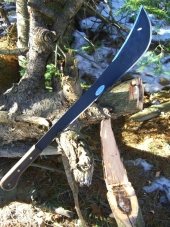Erica,
No need to apologize, it's easy to draw a different conclusion with only a few pictures to go by.
I'd think we are on the same path regarding steel in whatever form inside a rocket stove. In short: it will be eaten by the fire, in fact it is a very rapid corrosion process. Mainly due to the high temperatures combined with a relatively high oxygen and low carbon environment. Even stainless steel will buckle and give up in time.
The metal end in my design is there solely because of the opportunity to cool this actively using the incoming air for the secondary air intake. By cooling the feed, the secondary intake got fed hot air which will work much better. It's no use to go through several potentially troublesome construction details when there's no active cooling. By the way, only one of the extra openings of the feed tube is in use, the one facing the riser. This is done like this to create the opportunity to turn it around or even upside down when one side is worn out by the fire.
And yes there's an expansion joint between the steel and masonry. I fully agree with Ernie, the steel tube will crawl out of place without that. In the picture you'll see a white line between the left and right halves of the casting, that's an aluminum oxyde felt strip to seal both halves together. Casting the thing in one piece will result in major cracks. The same alu-oxy felt is around the steel tube to separate it from the casting.
The longest test run I've ever done with the small prototype lasted about 5 hours. I've let it run in the highest possible mode, needing constant attention and feeding, seriously trying to overheat the little critter. It still kept working as intended, coupled to a proper vertical chimney which had a too wide diameter, though. When moved outside in the garden, equipped with about two yards of bare vertical stove pipe, the top mode couldn't be reached and after an hour or so the fire crept up the feed. This prototype wasn't coupled to a bench or whatever, the high heat was taken away by means of two 16 gallon drums stacked on top of each other. The exhaust out the side of the steel litter bin which was used as the base, otherwise my testing equipment wasn't able to withstand the temperatures!
Can you tell us more about whether you've tracked long-term performance with full thermal-mass installations? Do you give specific limits for how much thermal mass, how long the heat-exchange channels can be, or how to calibrate for taller/shorter chimneys with your models?
I'm sorry, rocket mass heaters are few and far between in the Netherlands. I've conducted a single test run on only two of those, not enough data to draw conclusions except this: those full blown stoves had both the same spiky behaviour as the unalterated little model. And yes, the influence of chimney draft, i.e. gas velocity inside the stove, do have a large impact on performance. Virtually all woodstoves are made with large tolerances, the closer to the top range of performance the more difficulties to overcome.










